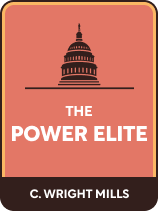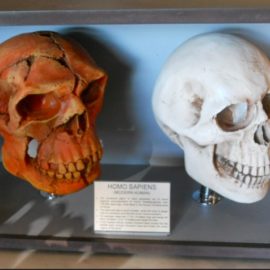

This article is an excerpt from the Shortform book guide to "The Power Elite" by C. Wright Mills. Shortform has the world's best summaries and analyses of books you should be reading.
Like this article? Sign up for a free trial here.
Who has more power in America—elected or unelected officials? Are civil service jobs provided based on merit?
Sociologist C. Wright Mills claims that the power elites are in charge in America. He explains that these “influencers” are unaccountable to the people, can exercise their power broadly, and have exploited many national institutions for their own benefit. Many of these elites are in civilian government.
Keep reading for Mills’s exposé of America’s government elite.
America’s Government Elite
In his book The Power Elite, Mills addresses “civilian government”: elected officials and appointed bureaucrats. He argues that federal bureaucratic agencies have slowly gained more and more power than elected officials at every level—officials who are far more accountable to the American people. This, essentially, now constitutes a government elite that wields an inordinate amount of influence over the entire nation. The process had three main steps: using party machinery, growing the bureaucracy, and appointing elites.
1) Using Party Machinery
Mills explains that, before the 20th century, American politicians mainly worked within the political party “patronage” system: Over the course of their careers, they started in local party politics, met party mentors and allies, and received pay-offs and positions of power based on loyalty. This was also true for America’s “civil service,” or government bureaucrats hired for specific technical positions—everything from school superintendents to chiefs of police. These positions were “rewards” given out to loyal party members. This system was built on corruption and graft, with people often exercising political power for their own personal benefit and giving positions to people they trusted.
(Shortform note: While the era of large patronage networks and political ‘machines’ is generally believed to have ended in the early 20th century, versions of it continued to operate up to and even after The Power Elite was written—especially in the Democratic Party and in the South. Political machines controlled or influenced politics on a local and state level well into the 20th century, like through Augusta Georgia’s “Cracker Party” or Huey Long’s control of Louisiana politics. Political machines even impacted federal politics—Richard J. Daley’s Cook County Democratic Party allegedly miscounted votes in the 1960 presidential election to favor Democrat John F. Kennedy, though this is still debated today.)
2) Growing the Bureaucracy
In the early 20th century, presidents like Theodore Roosevelt and especially Franklin Delano Roosevelt expanded the civil service and dismantled much of the patronage system of the past, explains Mills. This contributed to the centralization of power in two distinct ways.
First, the expansion of the civil service invested more power in federal non-elected positions. New federal agencies within the executive branch had power over major aspects of American life. Since these positions were appointed, those filling them were only accountable to those in power and not the public at large.
Second, reforming the patronage system took wealth and power away from low-level party members. The patronage system made elites provide lower-level officials with jobs in exchange for their loyalty. This allowed for some degree of upward mobility and elite accountability. Reforms of this era cracked down on bribery and graft, but they crucially still allowed elites to control government positions. Despite these reforms, Mills argues, America still doesn’t have a merit-based and apolitical civil service since politicians can create or destroy civil service jobs at will.
3) Appointing Elites
Mills argues that the larger, stronger bureaucratic agencies in the executive branch allow elites to consolidate their power further. He believes these agencies allow elites inside and outside the government to control major American political decisions—things like war and peace, the shape of the economy, and how power is distributed. What the average American sees as politics (elections, Congress, and so on) is actually just a mid-level, intermediary process for determining how to carry out the will of these elite few.
For example, Mills notes that modern American liberals and conservatives have the same overall goal in economic policy: private ownership of large corporations that determine major aspects of American life. The difference is in their approach: Liberals believe safety nets and increased public spending (though less profitable in the short term) maintain the long-term stability of the corporate economic system. Conservatives, however, believe in maximizing short-term corporate profit by cutting taxes and government spending.
Top bureaucratic positions (secretary of defense, secretary of state, head of the CIA, and so on) are often given to corporate and military elites rather than career politicians or bureaucrats—allowing for further integration and centralization of the American power elite. For example, President Eisenhower’s initial cabinet was jokingly referred to as “nine millionaires and a plumber” because it consisted of nine corporate executives and the president of a pipefitter union.
| Bureaucratic Behemoths To contextualize Mills’s grave concerns about elite bureaucracy, we can look to one of The Power Elite’s major influences: Franz Leopold Neumann’s Behemoth, a 1942 book outlining the internal structure and workings of Nazi Germany. Neumann defined the Nazi state as a chaotic blend of private monopolies and government institutions operating with little to no oversight. According to Neumann, this mess of private and public institutions had two main things in common: First, they were ultimately all accountable only to those at the top—Hitler and his closest allies. Second, they collectively controlled every aspect of life in Nazi Germany. Neumann’s analysis of the Nazi state helps inform why Mills is so alarmed at what he views as an unaccountable blend of the military, large corporations, and government bureaucracy in the United States. |

———End of Preview———
Like what you just read? Read the rest of the world's best book summary and analysis of C. Wright Mills's "The Power Elite" at Shortform.
Here's what you'll find in our full The Power Elite summary:
- How a group of corporate elite controls America's politics and economics
- How the elite exploit America's institutions for their own benefit
- A look at the dangers that arise when citizens feel powerless






